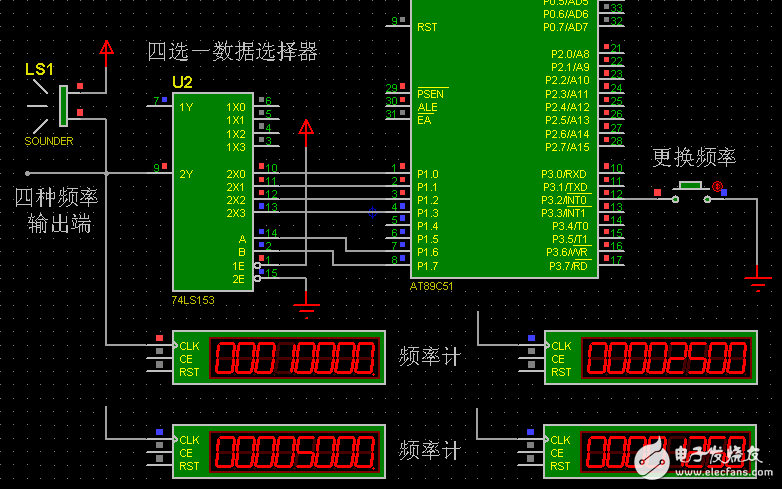/ / Write 51 single-chip program, output square wave.
//Requirement: The crystal oscillator is 12MHz, use T0 as the timer, and output the square wave of four frequencies in the lower four bits of P1:
// P1.3 = 1.25kHz, P1.2 = 2.5kHz, P1.1 = 5kHz, P1.0 = 10kHz
// In addition, the above four frequencies require a four-choice data selector, and then one of them is output.
//The output of P1.6 and P1.7 is used to control the selection bits of the four-select data selector, which are controlled by the P3.0 button.
//Best answer:
//This question was answered a year ago, and now the PROTEUS simulation image has been added to the blog.
//The title requires four frequencies that are output on the adjacent four interface lines, which is exactly twice as large, which can be done with a timed interrupt.
/ / The title also requires the use of a data selector, select a frequency by the button to output.
//The screenshot using the PROTEUS simulation is shown below.
//In the figure, a frequency meter and a Speaker are connected to the output for frequency detection.
//When the button is pressed, the output frequency can be rotated.
//The picture shows the detection results of the four frequencies in the picture. It can be seen that the output frequency is very ideal.
//The speaker of the PC can also hear the sound, the frequency of 10kHz is more harsh.

//The following program has been successfully simulated.
//------------------------------------------------ ---
#include
#define uchar unsigned char
#define TL_0SET (256 - 50) //Timed time is 50us
/ / The square wave period of the output will be 100us, 10kHz
Sbit P3_2 = P3^2; //for buttons
Sbit P1_0 = P1^0; //four frequency outputs
Sbit P1_1 = P1^1; //
Sbit P1_2 = P1^2; //
Sbit P1_3 = P1^3; //
Sbit P1_6 = P1^6; //Two selection control outputs
Sbit P1_7 = P1^7; //
Bdata uchar x = 0;
Sbit p16 = x^0;
Sbit p17 = x^1;
Uchar i, j;
//------------------------------------------------ ---
Void e0int() interrupt 0 //External interrupt 0 is used as a switch to control the four-select data selector
{
While(P3_2 == 0) {;} //wait for the button to release
x++;
If(x == 4) x = 0; //change the selection of the current output
P1_7 = p16;
P1_6 = p17;
}
//------------------------------------------------ ---
Void TIme0() interrupt 1 //T0 interrupt service routine
{ //T0 works in mode 2, automatically loading the initial value
i++;
j = i % 16; // take the lower four digits of i
j += x "6; / / combined control signal of the data selector
P1 = j; // output square wave of four frequencies and control signal
}
//------------------------------------------------ ---
Void main()
{
TMOD = 0x02; //T0 timing mode 2
TH0 = TL_0SET; // self-loading timing initial value
TR0 = 1; //Start T0
ET0 = 1;
IT0 = 1; //External interrupt 0 is triggered by falling edge
EX0 = 1; //External Interrupt 0 allows
EA = 1;
While(1) {;}
}
//------------------------------------------------ ---
Micro Speaker,Mini Micro Speaker,Micro Bluetooth Speaker,Waterproof Micro Speaker
NINGBO SANCO ELECTRONICS CO., LTD. , https://www.sancobuzzer.com